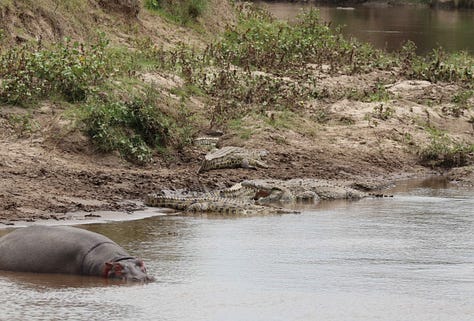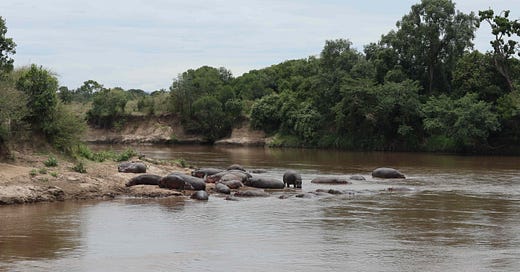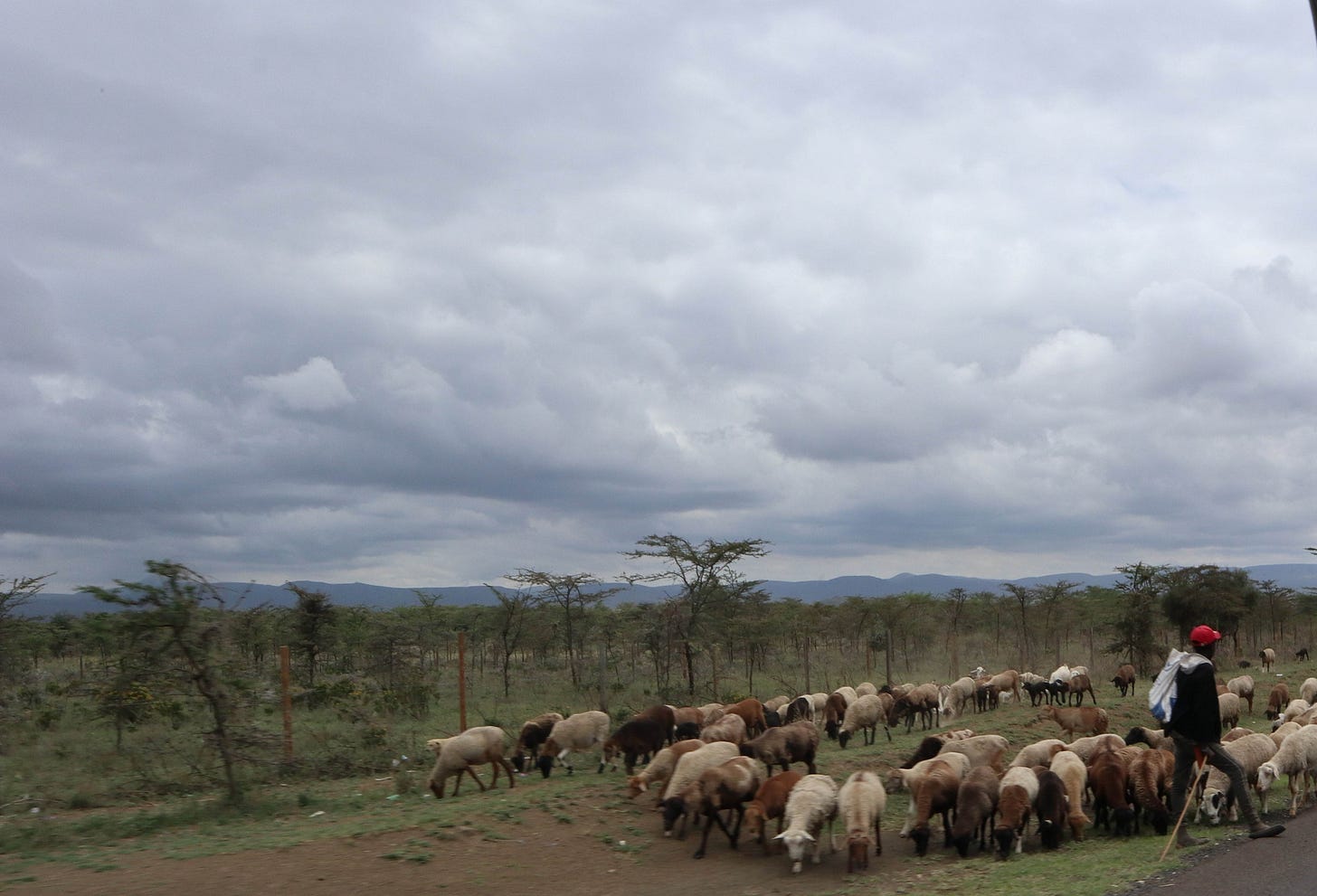The Mara River is the colour of strong milky tea as it flows under the bridge, on its way to Tanzania and, eventually, Lake Victoria. Its swift waters foam around rocks, turbulent and treacherous. On its banks there are other dangers – crocodiles coloured like the sand and water, and sleeping hippos. They appear so relaxed, they look as if they were poured onto the river bank, but I’m glad they’re on the far side of the river.
The menace I perceive in the Mara River is partly the unfamiliar wild animals, but it’s also the colour of the water. In New Zealand, when a river looks like that, it’s in flood after prolonged heavy rain. It would be eating away at the banks, picking up debris and perhaps threatening to swallow the road. But I’ve been in the Maasai Mara for a few days now, and I’ve barely seen a cloud, let alone rain. As far as I can tell, this is the usual colour for the Mara River.
It's not uncommon for the water of lakes and rivers to be coloured. I have fond memories of swimming in a river stained brown with tannin somewhere south of Westport. Glacial lakes such as Takapō are turquoise as a result of rock ground to a powder by the glaciers. Blooms of cyanobacteria can turn waters a milky green. But when waters turn brown and opaque, the cause is usually sediment – fine soil particles washed from the land.
I’ve written about sediment before, when I began looking at the issues with water in New Zealand. In writing that article, I learned that excess sediment causes a lot of problems. It prevents plant growth by blocking light. It scours algae off rocks, depriving fish and insects of food, and fills in the nooks and crannies between rocks, depriving insects of habitat. It alters the flow of rivers and streams, increasing the risk of flooding. And it even affects the sea, for example by smothering shellfish beds in harbours. We have a big problem with it in New Zealand, because so much of our original forest has been cleared.
But why was there so much sediment in the Mara River? The short answer is that sediment ends up in rivers because of erosion, so the Mara River has a lot of sediment because the land around it is eroding. That doesn’t really answer my question, though. Why is there so much erosion?
As I travelled around Kenya, one thing I noticed was a lot of bare earth on roadsides. Bare earth, with no plants to hold it together, is particularly prone to erosion. In New Zealand, any patch of dirt by the roadside is quickly smothered by fast-growing weeds. The only places which are bare are slip-prone banks like the one below my driveway. But in Kenya, the roadsides were a mix of bare earth and close-cropped grass. The reason was obvious. Everywhere I went, I’d see men driving herds of cattle, sheep and goats. I even saw them on the Ngong Road in Karen, only about 10 kilometres from central Nairobi.
I can remember farmers in New Zealand occasionally stringing up temporary electric fences on the roadside and grazing their stock on the ‘long paddock’. But in Kenya, it seemed as if every bit of greenery was being made use of. I didn’t see long grass anywhere.
While there is some debate about exactly how long there have been cattle in Africa, it is certainly millennia. Has their grazing always put so much pressure on the land that there is bare earth everywhere? What about the massive herds of wild animals which roamed the savanna – and still do in some areas? Is the level of sediment I saw in the Mara River, and other Kenyan waterways, the way it has always been?
When I started looking, these questions turned out to be fairly complex, and much wider than Kenya, or even east Africa. There’s a fundamental question about erosion which applies to all tropical areas. Although New Zealand has a serious erosion problem, we are something of an outlier. As a rule, tropical countries suffer much more from erosion than temperate countries like ours. East Africa is no exception. The question, though, is whether that is because of some inherent vulnerability in the tropical soils and climate, or whether it’s because of the way the land is managed.
One climatic reason for high levels of erosion became apparent to me when I was sitting in a Nairobi traffic jam. The day had been fine, but the sky darkened in the mid-afternoon, then the heavens opened. The rain was so heavy that within minutes there were rivers running down the road. I’ve seen heavy rain in New Zealand, but not like this. Because land can only absorb so much water in a given time, tropical downpours like the one I experienced are one part of the erosion problem.
The distinct wet and dry seasons are another climatic reason for erosion in places like Kenya. At the start of the wet season, a lot of the vegetation has died back and there is more bare ground. Once the rain comes, it takes time for plants to start growing. The land is therefore not well-protected from rain early in the season.
There are other climate factors too. Big variations in rainfall from one year to the next are common. As a result, the natural vegetation doesn’t form the kind of stable forest that we see somewhere like New Zealand, where the rain is reliable.
As well as climate, there are other natural reasons for Kenya to have high levels of erosion. Some soil types are more vulnerable than others, and the soils in semi-arid parts of Kenya are particularly fragile. Sloping land is more vulnerable. I haven’t been able to find information about the impact that the wildlife might have, but there must be some. Hippos, in particular, trample around on the river bank as they move in and out of the water.



All of this means that even before we take human activity into account, Kenyan waterways such as the Mara River carry a lot of sediment. Murky brown water was probably quite common, even before people began herding cattle. In theory, once people started keeping cattle and practising other forms of agriculture, there may have been an increase in erosion, but I can’t find any papers documenting the amounts of sediment carried by rivers during this time.
What I have found, though, are papers looking at sediment levels and erosion in more recent times. One paper, which looks at the basin of the Mara River, covers the last 2000 years. Another paper, which looks at an area further north, around Lake Naivasha, covers the last 200 years. A third paper, which looked at several different areas, covers the middle of the 20th century.
All three papers agreed that the 20th century saw a major increase in erosion and sedimentation. Around Lake Naivasha, the increase happened in the 1920s, as traditional agricultural systems were disrupted and replaced by colonial farms growing crops like coffee, cotton, rubber and tea. There were also large-scale displacements of people from their traditional lands. The large increase in erosion indicates that the colonial farms provided less protection for the soil than the traditional farms.
The paper which looked back 2000 years documented increases in sediment as far back as the 1700s. However, the big increases in sediment happened in the 1960s. This finding is echoed by the paper which covered the middle of the 20th century, which documented accelerating erosion from 1960 onwards.
There were a number of factors which contributed to increased erosion during this period. After independence, people didn’t necessarily go back to their traditional farming systems – often, that simply wasn’t possible as they’d been moved to different parts of the country. Post-colonial governments found it difficult to deny requests for land. The population increased. Livestock numbers increased too, particularly sheep and goats.
As far as I can tell, the high sediment levels and erosion problems haven’t reduced. The colour I observed in the Mara River is a sign of one of Kenya’s major environmental challenges – one that I didn’t know about until I saw the river and wondered about its colour. As a result, I didn’t go looking for Kenyan erosion experts to tell me what they are doing about it while I was over there. However, what I’ve been able to find since returning home suggests that Kenyans are working on similar kinds of solutions to New Zealand. They are documenting where the risk is greatest to better target their management. They are replanting their denuded forests. They are working with local communities.
But my favourite approach, which I heard about on the BBC podcast The Climate Question, is the ‘earth smile’. Earth smiles are shallow semicircular holes, about 5 metres long, which are dug into the soil. It’s the semicircular shape, which looks like a smile, which gives them their name. Because they hold the rainwater for longer, they grow more grass, which holds the soil better. They’re the initiative of a joint Dutch-Kenyan organisation called Justdiggit. Hundreds of thousands of earth smiles have been dug so far.







You opened my eyes. I never thought about the harm sediment could cause. Glad the Kenyan gov is implementing solutions. 🙏
Earth smiles 🙂 I love these things we learn from you! Your posts are both incredibly important and enjoyable. I have sent this to my friends and relatives in New Zealand as well. Thanks for such a good read to start my Sunday.